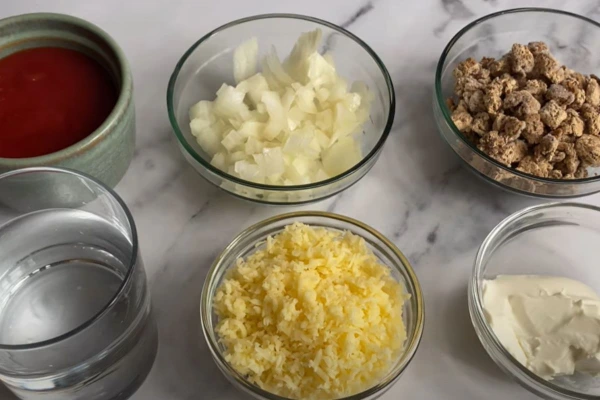Unraveling the Mystery: Lasagna vs. Lasagne
Linguistic Roots: Understanding Lasagna and Lasagne
Navigating through the maze of pasta names can feel like a tricky quiz. But fear not! The key to unlocking the difference between lasagna and lasagne lies in understanding their linguistic roots. “Lasagna” is commonly used in American English, while “lasagne” is preferred in British English. But, there’s more to it than just regional preferences.
Etymology and Language Influence
The word “lasagna” comes from the Italian “lasagna,” referring to one sheet of pasta or one slice of a pasta dish. On the other hand, “lasagne,” the plural form, is used to describe multiple sheets or slices. Interestingly, the singular form, “lasagna,” has become the standard in American English—a rare linguistic simplification of what is typically a more complex dish.
This distinction is crucial for understanding why different English-speaking countries have adopted different forms of the word.
Dictionary Definitions and Usage
By exploring the roots of “lasagna” and “lasagne,” we’ve peeled back the first layer of our pasta mystery. As we continue our exploration, we’ll delve deeper into how these terms vary across different cultures and culinary traditions, enhancing our appreciation for this globally adored dish.
Linguistic Origins and Definitions
Regional Preferences: Lasagna in Different Cultures
The tale of lasagna versus lasagne isn’t just a story of two spellings; it’s a reflection of how deeply food can be woven into the fabric of culture. Each variant tells a story of migration, adaptation, and personal taste, tracing a path through kitchens around the world.
Lasagna in Italy vs. Lasagne in English-Speaking Countries
In Italy, the birthplace of this beloved dish, “lasagne” is the correct plural term used to describe this layered pasta delicacy in its entirety. It’s not just about multiple sheets of pasta; it’s about the layers of ragù, béchamel, and cheese coming together in perfect harmony. As the dish left Italy’s borders and meandered through English-speaking countries, its name subtly shifted in response to linguistic tendencies and pronunciation ease. Thus, in the United States, the singular “lasagna” has come to represent the whole dish, not just a single noodle.
Conversely, other English-speaking regions such as the UK, Australia, and Canada, have clung to the original plural, “lasagne,” to denote the collective culinary experience. This adherence could be seen as a nod to a more traditional approach to Italian cooking terms, preserving the authentic pluralization as used in Italian.
The Impact of Migration and Globalization
The spread of lasagne from its Italian roots to becoming a staple in various countries illustrates the broader trends of migration and globalization. As Italian immigrants set up new homes across the globe, they brought their culinary traditions with them, planting the seeds for regional variations and nomenclature adaptations. The globalization of Italian cuisine helped cement lasagna/lasagne in different locales, each adapting the dish to local tastes and ingredient availability.
This adaptation goes beyond simple translation. The story of lasagna and lasagne is thus also a story of cultural integration, showcasing how food serves as a bridge between tradition and innovation.
As we continue to unravel the intricate differences between lasagna and lasagne, it becomes clear that the variations in spelling mirror deeper societal and cultural currents
Cultural and Regional Variations
Is There a Culinary Difference?
While the spelling differences between lasagna and lasagne may initially seem purely linguistic, they can occasionally hint at subtle variations in how the dish is prepared and perceived in different regions. This part delves into whether these spellings reflect distinct culinary practices or if they are merely two sides of the same delicious pasta coin.
Recipe Variations and Ingredients
Fundamentally, both “lasagna” and “lasagne” refer to the same layered pasta dish that is beloved worldwide. However, the nuances in preparation and ingredient choices can vary by region, influenced by local tastes and available ingredients. In Italy, for instance, the classic lasagne alla Bolognese uses sheets of pasta layered with ragù, béchamel sauce, and Parmigiano-Reggiano. This version is often strictly adhered to as a reflection of Italian culinary heritage.
In contrast, outside of Italy, particularly in places like the United States and the UK, you might find “lasagna” recipes that include variations like the addition of ricotta cheese, which is not traditional in Italian versions. Additionally, there might be differences in the types of pasta used, with some international versions utilizing no-boil noodle options that are more convenient for quick preparation.
Regional Recipe Adaptations
The adaptation of lasagna recipes in different countries can also reflect regional dietary preferences and innovations. For example, in the United States, it’s not uncommon to find “lasagna” that includes a variety of meats like sausage or ground beef, veering away from the traditional Italian ragù. Vegetarian versions are also popular, incorporating layers of vegetables like spinach, mushrooms, and zucchini.
In other English-speaking countries, where the spelling “lasagne” is more common, the recipes may stick closer to traditional Italian methods, though local variations still occur. For example, in Australia, it’s popular to include a mixture of béchamel and ricotta in the layers, blending Italian tradition with local preferences.
These culinary variations show that while the basic structure of the dish remains consistent, regional influences significantly shape its final form. This adaptability of lasagna/lasagne not only makes it a versatile dish but also allows it to resonate with a wide array of palates and dining traditions across the globe.
Perceptions and Modern Usage of Lasagna vs. Lasagne
Media and Culinary Influences
The way lasagna and lasagne are presented in media and culinary circles can greatly influence public perception and usage of these terms. From cookbooks to cooking shows and food blogs, the representation of this dish varies, subtly shaping how different cultures perceive and prepare lasagna.
Media and Culinary Influences
In the United States, “lasagna” is frequently featured in both regional and national media as a comforting, hearty dish, often loaded with cheese and meat. This portrayal aligns with American preferences for rich, indulgent meals. Culinary shows and websites might focus on quick, easy versions of lasagna, using ready-made ingredients to suit fast-paced lifestyles. These adaptations often emphasize convenience and comfort, reflecting broader American culinary trends.
In contrast, British and other English-speaking media that use the term “lasagne” tend to highlight more traditional Italian cooking techniques. Cooking shows, magazines, and cookbooks might focus on the authenticity of the ingredients, such as homemade pasta sheets or slow-cooked ragù. This approach not only respects the dish’s origins but also caters to a culinary audience that values traditional methods and authenticity.
Public Perception and Confusion
Despite the widespread popularity of the dish, there remains some confusion among the public about whether there is a significant difference between “lasagna” and “lasagne.” Surveys and online forums often reveal questions about the terms, with many people unsure if they refer to different recipes or merely different spellings.
This can sometimes lead to further misunderstandings among students and enthusiasts seeking to learn about global cuisine.
Addressing Common Questions



